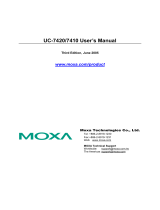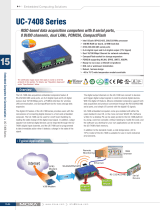
Compiling tcps2.c..................................................................................................... 2-16
Uploading tcps2-release and Running the Program ................................................. 2-17
Testing Procedure Summary .................................................................................... 2-19
Chapter 3 Managing Embedded Linux ........................................................................3-1
System Version Information..................................................................................................... 3-2
System Image Backup.............................................................................................................. 3-2
Upgrading the Firmware............................................................................................. 3-2
Loading Factory Defaults........................................................................................... 3-5
Enabling and Disabling Daemons............................................................................................ 3-5
Setting the Run-Level.............................................................................................................. 3-8
Adjusting the System Time...................................................................................................... 3-9
Setting the Time Manually......................................................................................... 3-9
NTP Client................................................................................................................ 3-10
Updating the Time Automatically............................................................................ 3-10
Cron—daemon to Execute Scheduled Commands .................................................................3-11
Connecting Peripherals.......................................................................................................... 3-12
USB Mass Storage.................................................................................................... 3-12
CF Mass Storage ...................................................................................................... 3-12
Chapter 4 Managing Communications........................................................................4-1
Telnet / FTP ............................................................................................................................. 4-2
DNS ......................................................................................................................................... 4-2
Web Service—Apache............................................................................................................. 4-3
Saving a Web Page to the CF Card............................................................................ 4-5
IPTABLES............................................................................................................................... 4-6
NAT........................................................................................................................................ 4-10
NAT Example .......................................................................................................... 4-10
Enabling NAT at Bootup.......................................................................................... 4-11
Dial-up Service—PPP.............................................................................................................4-11
PPPoE.................................................................................................................................... 4-15
NFS (Network File System)................................................................................................... 4-18
Setting up UC-7420/7410 as an NFS Server............................................................ 4-18
Setting up UC-7420/7410 as an NFS Client............................................................. 4-19
Mail........................................................................................................................................ 4-19
SNMP .................................................................................................................................... 4-20
Open VPN.............................................................................................................................. 4-21
Chapter 5 Programmer’s Guide....................................................................................5-1
Flash Memory Map.................................................................................................................. 5-2
Linux Tool Chain Introduction................................................................................................. 5-2
Debugging with GDB.............................................................................................................. 5-4
Device API............................................................................................................................... 5-4
RTC (Real Time Clock)........................................................................................................... 5-4
Buzzer...................................................................................................................................... 5-5
WDT (Watch Dog Timer) ........................................................................................................ 5-5
UART....................................................................................................................................... 5-9
LCM....................................................................................................................................... 5-10
KeyPad....................................................................................................................................5-11
Make File Example.................................................................................................................5-11
Appendix A System Commands.....................................................................................A-1
Linux normal command utility collection............................................................................... A-1























